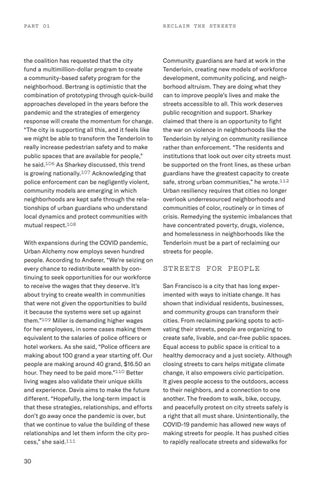PA RT 01
R E C L A I M T H E ST R E E TS
the coalition has requested that the city fund a multimillion-dollar program to create a community-based safety program for the neighborhood. Bertrang is optimistic that the combination of prototyping through quick-build approaches developed in the years before the pandemic and the strategies of emergency response will create the momentum for change. “The city is supporting all this, and it feels like we might be able to transform the Tenderloin to really increase pedestrian safety and to make public spaces that are available for people,” he said.106 As Sharkey discussed, this trend is growing nationally.107 Acknowledging that police enforcement can be negligently violent, community models are emerging in which neighborhoods are kept safe through the relationships of urban guardians who understand local dynamics and protect communities with mutual respect.108
Community guardians are hard at work in the Tenderloin, creating new models of workforce development, community policing, and neighborhood altruism. They are doing what they can to improve people’s lives and make the streets accessible to all. This work deserves public recognition and support. Sharkey claimed that there is an opportunity to fight the war on violence in neighborhoods like the Tenderloin by relying on community resilience rather than enforcement. “The residents and institutions that look out over city streets must be supported on the front lines, as these urban guardians have the greatest capacity to create safe, strong urban communities,” he wrote.112 Urban resiliency requires that cities no longer overlook underresourced neighborhoods and communities of color, routinely or in times of crisis. Remedying the systemic imbalances that have concentrated poverty, drugs, violence, and homelessness in neighborhoods like the Tenderloin must be a part of reclaiming our streets for people.
With expansions during the COVID pandemic, Urban Alchemy now employs seven hundred people. According to Anderer, “We’re seizing on every chance to redistribute wealth by continuing to seek opportunities for our workforce to receive the wages that they deserve. It’s about trying to create wealth in communities that were not given the opportunities to build it because the systems were set up against them.”109 Miller is demanding higher wages for her employees, in some cases making them equivalent to the salaries of police officers or hotel workers. As she said, “Police officers are making about 100 grand a year starting off. Our people are making around 40 grand, $16.50 an hour. They need to be paid more.”110 Better living wages also validate their unique skills and experience. Davis aims to make the future different. “Hopefully, the long-term impact is that these strategies, relationships, and efforts don’t go away once the pandemic is over, but that we continue to value the building of these relationships and let them inform the city process,” she said.111 30
STREETS FOR PEOPLE San Francisco is a city that has long experimented with ways to initiate change. It has shown that individual residents, businesses, and community groups can transform their cities. From reclaiming parking spots to activating their streets, people are organizing to create safe, livable, and car-free public spaces. Equal access to public space is critical to a healthy democracy and a just society. Although closing streets to cars helps mitigate climate change, it also empowers civic participation. It gives people access to the outdoors, access to their neighbors, and a connection to one another. The freedom to walk, bike, occupy, and peacefully protest on city streets safely is a right that all must share. Unintentionally, the COVID-19 pandemic has allowed new ways of making streets for people. It has pushed cities to rapidly reallocate streets and sidewalks for
